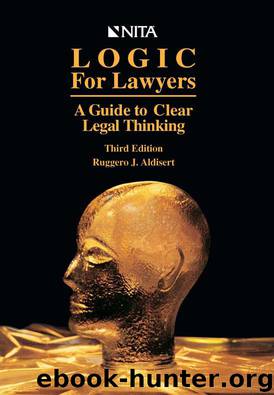Logic for Lawyers: A Guide to Clear Legal Thinking by Aldisert Ruggero J. Hon

Author:Aldisert, Ruggero J., Hon. [Aldisert, Ruggero J., Hon.]
Language: eng
Format: epub
Publisher: National Institute for Trial Advocacy
Published: 2015-03-10T16:00:00+00:00
AN ANALYSIS OF LORD DIPLOCK’S PREMISES
The minor premise then becomes obvious:
Minor Term Middle Term
The Borstal officers did or did not act as described in (1) and (2).
As does the conclusion:
Minor Term Major Term
Therefore, the Borstal officers are or are not liable .
LORD DIPLOCK’S METHOD OF ANALOGY
It may be useful now to summarize the facts considered by Lord Diplock when he utilized the method of analogy. His inquiry was decided into two stages. The first was to decide if the plaintiffs’ interpretation of the leading case of Donoghue v. Stevenson 2 was correct.
In Donoghue Lord Atkin had warned, “it is of particular importance to guard against the danger of stating propositions of law in wider terms than is necessary.” Lord Diplock pointed out that the plaintiff, Dorset Yacht Co., disregarded the warning by seeking “to treat as a universal not the specific proposition of law in Donoghue v. Stevenson which was about a manufacturer’s liability for damage caused by his dangerous products but the well known aphorism used by Lord Atkin to describe a ‘general conception of relations giving rise to a duty of care.’”:
You must take reasonable care to avoid acts or omissions which you can reasonably foresee would be likely to injure your neighbour. Who, then, in law is my neighbour? The answer seems to be—persons who are so closely and directly affected by my act that I ought reasonably to have them in contemplation as being so affected when I am directing my mind to the acts or omissions which are called in question.
Lord Diplock explained that this aphorism is to be “[u]sed as a guide to characteristics which will be found to exist in conduct and relationships which give rise to a legal duty of care,” but “misused as a universal it is manifestly false.” He went on to demonstrate that in English law there are many instances in which no legal liability would be incurred where an act or omission by one party causes loss or damage to another, even though that loss or damage might have been anticipated. His examples included:
You may cause loss to a tradesman by withdrawing your patronage even though the goods supplied are entirely satisfactory;
You may damage your neighbour’s land by intercepting the flow of percolating water to it even though the interception is of no advantage to yourself;
You need not warn him of a risk of physical danger to which he is about to expose himself unless there is a special relationship between the two of you such as that of occupier of land and visitor ;
You may watch your neighbour’s goods being ruined by a thunderstorm though the slightest effort on your part could protect them from the rain and you may do so with impunity unless there is some special relationship between you such as that of bailor and bailee.
Lord Diplock then noted that the propositions of law in Donoghue were not applied in Hedley Byrne & Co. Ltd. v. Heller & Partners Ltd., which involved careless words rather than careless deeds.
Download
This site does not store any files on its server. We only index and link to content provided by other sites. Please contact the content providers to delete copyright contents if any and email us, we'll remove relevant links or contents immediately.
Being Heard by Faith Pincus(238)
Logic for Lawyers: A Guide to Clear Legal Thinking by Aldisert Ruggero J. Hon(207)
Logic for Lawyers: A Guide to Clear Legal Thinking by Ruggero J. Aldisert(198)
Death of a Law Firm: Staying Strong in the Global Legal Market by Jaap Bosman(186)
Untangling Fear in Lawyering by Heidi K. Brown(162)
Evolutions of a Law Practice by Barry Seidel(160)
